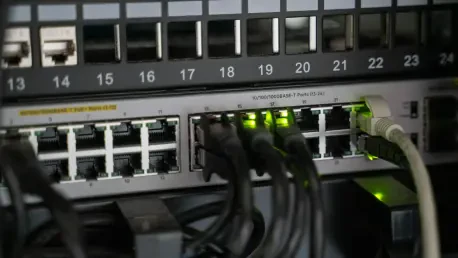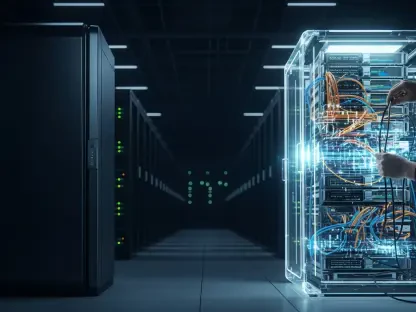Navigating the AI Infrastructure Crisis in a Booming Market
In an era where artificial intelligence is reshaping industries at an unprecedented pace, the backbone of this revolution—data center infrastructure—faces a critical test, especially as AI workloads demand computational power far beyond the capacity of single facilities. With the market for interconnect solutions witnessing explosive growth, projected to expand significantly over the next few years, the challenge lies in overcoming bottlenecks that hinder the seamless transfer of massive data volumes across geographically dispersed data centers. Cisco’s recent unveiling of the 8223 routing system, powered by the Silicon One P200 chip, has sparked intense interest among industry stakeholders. This analysis delves into the market dynamics surrounding AI networking, evaluates Cisco’s innovation against competitors, and explores the trends and projections shaping the future of scale-across solutions. The stakes are high as hyperscalers and enterprises alike seek robust systems to support the relentless rise of AI applications.
Market Trends and Competitive Dynamics in AI Networking
Explosive Growth in Distributed Computing Needs
The AI infrastructure market is undergoing a seismic shift as the limitations of traditional data center models become increasingly apparent. Single facilities struggle with space constraints, power consumption, and cooling demands when handling the enormous processing requirements of large language models. Industry reports indicate a surge in demand for distributed computing architectures, with a growing number of companies opting to spread workloads across multiple locations. This transition has fueled a robust market for high-capacity interconnect solutions, as businesses prioritize systems capable of managing erratic, high-volume data flows. The economic impact is substantial, with investments in networking hardware expected to rise sharply between 2025 and 2027, driven by the urgent need to maintain efficiency in AI training and deployment processes.
Cisco’s 8223 Router: A Market Disruptor with Unique Capabilities
Cisco has positioned itself as a formidable player in this burgeoning sector with the launch of its 8223 router, boasting an industry-leading capacity of 51.2 terabits per second. This system, equipped with 64 ports of 800-gigabit connectivity, is engineered to address the specific pain points of AI workloads through features like deep buffering to absorb traffic spikes and prevent congestion. Its compact design and emphasis on power efficiency cater to the market’s growing focus on sustainable operations, a critical factor as energy costs continue to climb. Furthermore, the router’s ability to support long-distance connections up to 1,000 kilometers via advanced optics makes it a compelling choice for hyperscalers managing regionally dispersed facilities. While the technology sets a high benchmark, its market penetration will depend on real-world performance and integration with diverse infrastructures.
Competitive Landscape: A Three-Way Battle for Dominance
The race to dominate the AI networking space is intensifying, with Cisco facing stiff competition from industry giants like Broadcom and Nvidia. Broadcom’s early entry with innovative chip designs has secured a foothold among key clients, while Nvidia leverages its strong relationships with high-profile customers to push tailored solutions. Cisco, however, brings a legacy of enterprise trust and strategic partnerships with hyperscalers like Microsoft and Alibaba Cloud, giving it a unique edge in scalability and ecosystem support. Market analysts note that differentiation lies not just in hardware specifications but in adaptability to evolving standards and security protocols. As each vendor carves out its niche, the competitive dynamics suggest a fragmented market where customer preferences for interoperability and cost-efficiency will ultimately determine the leader.
Emerging Trends: Sustainability and Regulatory Pressures
Beyond technological advancements, the AI networking market is increasingly shaped by external factors such as sustainability mandates and regulatory frameworks. Data centers are under scrutiny for their environmental footprint, prompting vendors to prioritize energy-efficient designs in their offerings. Cisco’s compact chassis and power-optimized systems align with this trend, potentially appealing to enterprises facing strict compliance requirements. Additionally, geopolitical considerations and data sovereignty laws are influencing where and how distributed networks are deployed, adding layers of complexity to market strategies. Looking ahead, the push for greener technologies and standardized protocols is likely to accelerate, reshaping vendor priorities and customer expectations in profound ways.
Future Projections: Where Is the Market Headed?
Scaling Investments and Technological Innovations
Projections for the AI infrastructure market point to sustained growth, with interconnect solutions at the forefront of capital expenditure. Analysts anticipate that investments in scale-across networking will see a significant uptick as more companies adopt distributed computing models. Technological innovations, particularly in optics and chip design, are expected to further enhance the speed and reach of interconnects, enabling even broader geographic distribution of workloads. Cisco’s programmable hardware, which allows for updates without costly replacements, positions it favorably to adapt to these advancements. However, the pace of adoption may vary across regions due to differences in infrastructure readiness and economic conditions, creating a patchwork of opportunities and challenges for vendors.
Hyperscaler Influence and Industry Standards
Hyperscalers such as Microsoft and Lumen are poised to play a pivotal role in shaping the future of AI networking. Their early adoption of solutions like Cisco’s 8223 router signals strong market validation and could drive the establishment of industry-wide standards for interconnectivity. Collaborative efforts between hardware providers and these large-scale operators are likely to focus on interoperability, ensuring that disparate systems can work seamlessly together. This trend may lead to a convergence of technologies over the next few years, reducing fragmentation and fostering a more cohesive market environment. For smaller enterprises, this could lower entry barriers, democratizing access to cutting-edge AI infrastructure solutions.
Potential Risks and Market Uncertainties
Despite the optimistic outlook, several risks loom on the horizon for the AI networking market. Latency issues in long-distance connections, even with advanced optics, remain a concern that could impact performance for time-sensitive applications. Security vulnerabilities in distributed networks also pose a threat, necessitating robust encryption and threat mitigation strategies. Cisco’s inclusion of post-quantum-resilient algorithms is a step in the right direction, but the evolving nature of cyber risks requires continuous vigilance. Additionally, market uncertainties around regulatory changes and fluctuating energy costs could disrupt investment plans, compelling vendors to adopt flexible pricing and deployment models to retain customer trust.
Reflecting on Market Insights and Strategic Pathways
Looking back, this analysis underscores the transformative potential of Cisco’s 8223 router in addressing critical bottlenecks within the AI infrastructure market. The competitive landscape, marked by fierce rivalry with Broadcom and Nvidia, reveals a sector brimming with innovation yet challenged by the need for adaptability and integration. Trends toward sustainability and hyperscaler-driven standardization emerge as defining forces that shape market trajectories. For stakeholders, the path forward involves strategic investments in solutions that balance performance with energy efficiency, prioritizing partnerships that enhance ecosystem compatibility. Businesses are encouraged to pilot new technologies in controlled environments to mitigate risks, while keeping a close eye on regulatory shifts that could alter operational landscapes. Ultimately, navigating this dynamic market requires a blend of foresight and agility, ensuring that the promise of AI’s growth is matched by infrastructure capable of sustaining it.









